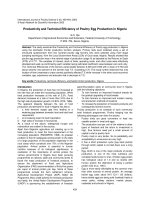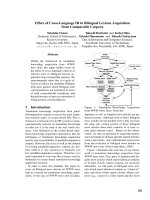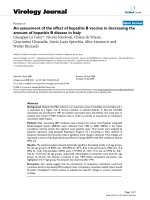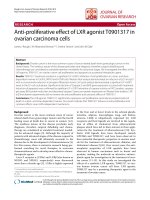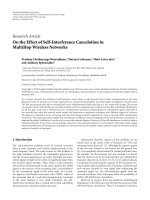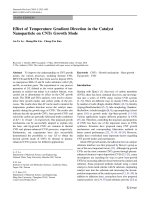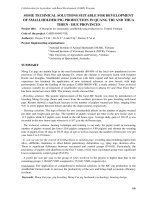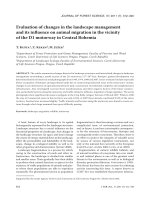Effect of canopy management and chemical manipulation on morphological attributes of off season production in annual Moringa cv. PKM1
Bạn đang xem bản rút gọn của tài liệu. Xem và tải ngay bản đầy đủ của tài liệu tại đây (292.53 KB, 7 trang )
Int.J.Curr.Microbiol.App.Sci (2019) 8(2): 2642-2648
International Journal of Current Microbiology and Applied Sciences
ISSN: 2319-7706 Volume 8 Number 02 (2019)
Journal homepage:
Original Research Article
/>
Effect of Canopy Management and Chemical Manipulation
on Morphological Attributes of Off Season Production in
Annual moringa cv. PKM1
C. Sharmila Bharathi1*, L. Pugalendhi2 and B. Mohan3
1
Krishi Vigyan Kendra, Veterinary College and Research Institute Campus,
TANUVAS, Namakkal, Tamil Nadu, India
2
HC&RI, TANUVAS, TNAU, Coimbatore, India
3
VC&RI, TANUVAS, Namakkal, Tamil Nadu, India
*Corresponding author
ABSTRACT
Keywords
Annual moringa,
Canopy
management,
Chemical,
Manipulation
Article Info
Accepted:
20 January 2019
Available Online:
10 February 2019
A field experiment was conducted at Krishi Vigyan Kendra farm, Veterinary College and
Research Institute Campus, Namakkal, Tamil Nadu during 2012 - 2014 to study the
influence of Canopy management and chemical manipulation on morphological attributes
of off season production in annual moringa cv. PKM 1. The technical programme
comprised of two levels of mulching, three pruning levels and three levels of chemical
spray (sprayed twice at one and two months after pruning). Among the three different
combinations studied, the combination Black polyethylene mulch + July pruning + water
spray registered the maximum plant height (3.96 m).Regarding number of branches, the
black polyethylene mulch recorded the highest number of primary branches / tree (6.27).
In case of pruning treatments, July pruning recorded the highest number of primary
branches per tree (5.90). Among the growth retardants, uniconazole 50ppm spray produced
more number of primary branches (5.31).
Introduction
Moringa (Moringa oleifera Lam.) popularly
called as the “drumstick tree which is an
indigenous vegetable, has gained its
importance due to its neutraceutical values
and considered as an indispensable plant for
health management. It is one of the most
incredible plants to the mankind and its
nutritional and medicinal properties have
immense potential to manage malnutrition,
and prevent and heal any maladies. This fast
growing, small to medium sized tree is used
as animal forage, source of nutrition,
medicine, water purification, cosmetics even
as biofuel. India is the largest producer of
moringa with an annual production of 1.1 to
1.3 million tonnes of tender fruits from an
area of 38,000 ha. Andhrapradesh leads in
both area and Production (15,665 ha),
followed by Karnataka (10,280 ha) and Tamil
Nadu (7,408 ha), whereas other states
2642
Int.J.Curr.Microbiol.App.Sci (2019) 8(2): 2642-2648
occupies an area of 4,613 ha only. In Tamil
Nadu both perennial and annual moringa
varieties are cultivated. Regulation of
morphological attributes by increasing root
zone temperature as well as to prevent the
entry of rain water using black polyethylene
film mulch, pruning in a right season and
foliar application of growth retardants in such
a way maximum flowering can be induced in
rainy and winter season in order to get yield
during off season. The optimum pruning
provides better condition for light, nutrition
and moisture for plant growth, which results
in timely commencement of reproductive
phase and thus, formation of more fruits. The
growth retardants are known for their effects
of suppressing vegetative growth and
inducing flowering in crop plants. Hence the
present investigation was carried out with a
view to find out the effect of canopy
management
practices
and
chemical
manipulation on morphological attributes of
off season production in Annual Moringa
cv.PKM1.
68 per cent at 14.22 hrs. The mean bright
sunshine hour day -1 was 7.4 with a mean
solar radiation of 429 cal cm-2 min-1. The soil
of the experimental site was red sandy loam
in texture with a pH of 7.16, available
nitrogen, available phosphorus and available
potassium. The experiment was laid out in
Factorial Randomized Block design with 3
factors in two replications.
Results and Discussion
The important morphological characters that
influence the development and productivity of
a crop are plant height and number of
branches. These morphological parameters
were differentially influenced by mulching,
different months of pruning and chemical
spray treatments.
Plant height at 120 days after pruning
Influence of mulching, pruning and chemical
spray on plant height showed highly
significant effect during off season (Table 1).
Materials and Methods
Mulching (M)
A field experiment was conducted at Krishi
Vigyan Kendra farm, Veterinary College and
Research Institute campus, TANUVAS,
Namakkal during August 2012 to March 2014
to study the influence of canopy management
and chemical manipulation on morphological
attributes in off season production of Annual
moringa cv.PKM1. The experimental site is
geographically situated in North western
agro-climatic zone of Tamil Nadu at 11
North latitude and 77 East longitude at an
altitude of 300 m above MSL.
The mean annual rainfall of Namakkal (mean
of 30 years) is 771 mm distributed over 47
rainy days. The mean maximum and
minimum temperatures are 31.5 and 21.4oC,
respectively. The relative humidity ranges
from 61 to 91 per cent at 07.22 hrs and 41 to
The plant height at 120 days after pruning
exhibited significant difference with regard to
mulching. M2 (black polyethylene mulch)
recorded the maximum plant height (2.99 m),
followed by M1 (without mulch) which
registered 2.89 m (Fig. 1). Better growth in
terms of plant height was observed in
mulched plots due to changes in soil and air
temperature near the cover, soil water balance
and nutrient availability when compared with
that of the unmulched trees (Gary Gordon et
al., 2010). Less soil compaction and hence
improved aeration under mulched soil have
also contributed to increased plant growth
(Liu et al., 2011). However effect of black
polyethylene mulch on plant height may be
attributed to increased soil temperature, which
changed plant microclimate as a result, faster
2643
Int.J.Curr.Microbiol.App.Sci (2019) 8(2): 2642-2648
plant growth was observed. This is in
conformity with the findings of QumerIqbal
et al., (2009).
Pruning (P)
Among the different months of pruning
compared, the plant height at 120 days after
pruning showed the significant difference.
The P2 (August pruning) recorded the
maximum height (3.02 m), which was on par
with P1(July pruning ) with a value of 2.99 m.
While P3 (September pruning) registered the
lowest plant height of 2.81 m. Considering the
canopy management practices, better growth
in terms of plant height in July pruning might
be due to the conducive climatic conditions.
Similar result was also reported by Kalicharan
(2012) in annual moringa. The enhanced plant
height might also be due to efficient
metabolism and effective source sink
relationship.
Pruning
increased
light
penetration in to the tree canopy, which might
have increased photosynthesis resulting in
higher plant height. These observations are in
agreement with the findings of Mehta et al.,
(2010) in tomato
Chemical spray (S)
The chemical spray showed the significant
difference for plant height at 120 days after
pruning
during
experimentation.
The
maximum plant height (3.34 m) was observed
in S1 (water spray), followed by S3 (mepiquat
chloride 50 ppm spray) with the value of 2.85
m. The least plant height was recorded (2.63
m) in S2 (uniconazole 50ppm spray).
Uniconazole treatment recorded a reduced
height of 0.71 m compared to water spray. As
a consequence, uniconazole 50 ppm spray
resulted in shorter trees. Growth retardants
shorten the growth by reducing internodal
length and blocking the oxidation of kaurene
to kaurenoic acid in gibberellin biosynthesis
(Monica Meijon et al., 2009). Growth
retardation by uniconazole was achieved by
the inhibition of GA synthesis. The positive
effect of uniconazole noticed in the present
study is in accordance with the findings of
Shanmugam et al., (2012).
Mulching and pruning (M x P)
The interaction effect between mulching and
pruning showed highly significant influence
on plant height at 120 days after pruning.
M2P2 (black polyethylene mulch and August
pruning) recorded the maximum plant height
(3.11 m), which was on par with M2P1 (black
polythene mulch and July pruning) with a
value of 3.09 m. It was followed by M1P2
(without mulch and August pruning) which
recorded 2.94 m. The least plant height (2.79
m) was registered in M1P3 (without mulch and
September pruning).
Pruning and chemical spray (P x S)
Significant difference was noticed on plant
height under the interaction of different
months of pruning and chemical spray
employed in the present investigation. The
maximum plant height (3.55 m) was in P1S1
(July pruning and water spray), which was on
par with P2S1 (August pruning and water
spray). It was followed by P3S1 (September
pruning and water spray), which recorded
2.95 m. The lowest value (2.55m) was
recorded in P1S2 (July pruning and
uniconazole 50 ppm spray).
Mulching and chemical spray (M x S)
The combined effect of mulching and
chemical spray on plant height showed
significant difference. The results indicated
that M2S1 (black polyethylene mulch and
water spray) recorded the maximum plant
height (3.62 m). It was followed M1S1
(without mulch and water spray) with a value
of 3.06 m. The least plant height (2.60 m) was
2644
Int.J.Curr.Microbiol.App.Sci (2019) 8(2): 2642-2648
showed in M2S2 (black polyethylene mulch
and uniconazole 50 ppm spray), which was on
par with M1S2 (without mulch and
uniconazole 50ppm spray).
Mulching, pruning and chemical spray (M
x P x S)
The combined effect of mulching, pruning
and chemical spray indicated the significant
influence on plant height at 120 days after
pruning. Among the three different
combinations studied, the combination
M2P1S1 (black polyethylene mulch + July
pruning + water spray ) registered the greatest
plant height (3.96 m), which was on par with
M2P2S1 (black polyethylene mulch + August
pruning + water spray ).
It was followed (3.17 m) by M1P1S1 (without
mulch + July pruning + water spray ) which
was on par with M1P2S1 (without mulch +
August pruning + water spray ) The least
plant height (2.53 m) was recorded in M2P1S2
(black polyethylene mulch + July pruning +
uniconazole 50 ppm spray ), which was on
par with M2P2S2 (black polyethylene mulch +
August pruning + uniconazole 50 ppm spray)
and with M1P1S2 (without mulch + July
pruning + uniconazole 50 ppm spray).
However, the lowest tree height was
registered by the chemical spray. Irrespective
of the mulch and pruning treatment,
uniconazole recorded a reduced height of 1.43
m.
Number of primary branches per tree
The number of primary branches per tree was
significantly influenced by the mulching,
pruning and growth retardant application
(Table 2).
Mulching (M)
The number of primary branches / tree
exhibited significant difference with regard to
mulching. Among the mulching treatments
studied, M2 (black polyethylene mulch)
recorded the highest number of primary
branches / tree (6.27), followed by M1
(without mulch) which recorded 3.90 number
of primary branches. Similarly branching was
maximized in black polyethylene mulched
trees followed by unmulched plants.
Prolific branching generally facilitates better
light penetration and augmentation of
assimilatory apparatus i.e., leaf area, which in
turn, enhanced higher photosynthetic activity.
Hence for crops like moringa, branching
could be encouraged with appropriate height.
Profuse branching in moringa resulted in
higher yields.
The superior performance exhibited by the
black polyethylene mulch treatment on
number of primary branches might be due to
FR: R ratio which plays a major role in
assimilates partitioning (Vijayakumar, 2001).
The ratio acts through the phytochrome
system
to
regulate
branching
and
photosynthate partitioning among branches
and roots. This is in conformity with the
findings of Ashrafuzzaman et al., (2011) in
chilli.
Pruning (P)
Among the months of pruning compared,
there was significant difference on the
number of primary branches per tree. The P1
(July pruning) recorded the highest number of
primary branches per tree (5.90) which was
followed by P2 (August) with 4.86 number of
primary branches, while P3 (September)
registered the lowest number of primary
branches per tree (4.50).
Among the months of pruning, July pruning
recorded more number of branches than other
pruning. This could be attributed to the
suppression of apical dominance, thereby
2645
Int.J.Curr.Microbiol.App.Sci (2019) 8(2): 2642-2648
diverting the polar transport of auxins towards
the basal nodes. Pruning breaks apical
dominance when apex bud removed or
headed back.
number of primary branches (5.31), which
was followed by S1 (water spray) (5.01 ). The
least number of primary branches were
observed under the plants sprayed with
50 ppm mepiquat chloride (S3) (4.93). With
regard to number of branches, significant
differences were manifested among the
growth retardant treatments.
This practice makes plant more branched and
dense which later on increased the fruit
number per plant. This is in conformity with
the findings of Kalicharan (2012) in annual
moringa.
Uniconazole 50 ppm spray induced more
number of branches. Uniconazole is a plant
growth retardant that could reduce plant stem
elongation and increase lateral growth.
Increased number of branches due to
uniconazole was also reported by Iyyakkannu
Sivanesan et al., (2011) in tomato.
Chemicals (S)
Significant difference was noticed on number
of primary branches per tree. Among the
chemicals tried, the plants sprayed with
uniconazole 50ppm (S2) produced more
Table.1 Influence of canopy management and chemical manipulation on plant height (m) at 120
days after pruning in annual moringa (Moringa oleifera Lam.) cv.PKM 1
Treatments
M1
M2
Mean
P1
P2
P3
Mean
M 1P 1
M 1P 2
M 1P 3
M 2P 1
M 2P 2
M 2P 3
Mean
Source
M
P
S
MP
PS
MS
MPS
S1
3.06
3.62
3.34
3.55
3.54
2.95
3.34
3.13
3.17
2.90
3.96
3.90
3.01
3.34
S2
2.66
2.60
2.63
2.56
2.62
2.71
2.63
2.58
2.68
2.72
2.53
2.56
2.71
2.63
SEd
0.02065
0.02529
0.02529
0.03576
0.04380
0.03576
0.06194
S3
2.95
2.76
2.85
2.88
2.91
2.77
2.85
2.99
2.97
2.89
2.77
2.85
2.65
2.85
Mean
2.89
2.99
2.94
2.99
3.02
2.81
2.94
2.90
2.94
2.83
3.09
3.11
2.79
2.94
CD (0.05)
0.04356
0.05335
0.05335
0.07545
0.09241
0.07545
0.13069
2646
Int.J.Curr.Microbiol.App.Sci (2019) 8(2): 2642-2648
Table.2 Influence of canopy management and chemical manipulation on number of primary
branches per tree in annual moringa (Moringa oleifera Lam.) cv.PKM 1
Treatments
M1
M2
Mean
P1
P2
P3
Mean
M 1P 1
M 1P 2
M 1P 3
M 2P 1
M 2P 2
M 2P 3
Mean
Source
M
P
S
MP
PS
MS
MPS
S1
4.20
5.83
5.01
5.65
4.82
4.57
5.01
4.80
4.05
3.75
6.50
5.60
5.40
5.01
S2
3.83
6.80
5.31
6.35
5.05
4.55
5.31
4.40
3.70
3.40
8.30
6.40
5.70
5.31
S3
3.66
6.20
4.93
5.70
4.72
4.37
4.93
4.15
3.50
3.35
7.25
5.95
5.40
4.93
SEd
0.08205
0.10049
0.10049
0.14211
0.17405
0.14211
0.24615
Mean
3.90
6.27
5.09
5.90
4.86
4.50
5.09
4.45
3.75
3.50
7.35
5.98
5.50
5.09
CD (0.05)
0.17311
0.21202
0.21202
0.29984
0.36723
0.29984
0.51934
Mulching and pruning (M x P)
The interaction effect between the mulching and
pruning showed highly significant influence on
number of primary branches per tree. M2P1
(black polyethylene mulch and July pruning)
recorded the highest number of primary
branches (7.35) per tree. It was followed by
M2P2 (black polyethylene mulch and August
pruning) which recorded 5.98 numbers of
2647
Int.J.Curr.Microbiol.App.Sci (2019) 8(2): 2642-2648
primary branches per tree. The lowest number
of primary branches (3.50) was registered in
M1P3 (without mulch and September pruning).
The interaction effects of pruning and growth
retardants were not significant.
Mulching and chemicals (M x S)
Significant difference was noticed on number of
primary branches per tree under the interaction
of mulching and chemicals employed in the
present study. The highest number of primary
branches per tree (6.80) was recorded in M2S2
(black polyethylene mulch + uniconazole 50
ppm) followed by M2S3 (black polyethylene
mulch + mepiquat chloride 50 ppm) which
recorded 6.20. The lowest number (3.66) was
observed in M1S3 (without mulch + mepiquat
chloride 50 ppm). The combined effects of
mulching, pruning and chemical spray were not
significant.
References
Ashrafuzzaman, M., M. Abdul Halim, Mohd
Razi Ismail, S.M. Shahidullah and M.
Alamgir Hossain. 2011. Effect of plastic
mulch on growth and yield of chilli
(Capsicum annuum L.). Braz. Arch. Biol.
Technol., 54(2): 321-330.
Liu, Yan Liu and Ganjun Yi. 2011. Effects of
film mulching on aroma components of
pineapple fruits. J. Agri. Sci., 3(3): 196201.
Garry Gordon, Wheeler G. Foshee, Stewart T.
Reed, James E. Brown and Edgar L.
Vinson. 2010. The effects of coloured
plastic mulches and row covers on the
growth and yield of Okra. Hort. Tech., 20
(1): 224-223.
Iyyakkannu Sivanesan, Moon Sook Son, Chae
Shin Lim and Byoung Ryong Jeong. 2011.
Effect of soaking of seeds in potassium
silicate and uniconazole on germination
and seedling growth of tomato cultivars,
Seogeon and Seokwang. Afr. J. Biotech.,
10 (35): 6743-6749.
Kalicharan, E. 2012. Studies on off season
production in moringa (Moringa oleifera
Lam.) ‘PKM1’. M.Sc. (Hort.) thesis
submitted to Horticultural College and
Research
Institute,
Tamil
Nadu
Agricultural University, Coimbatore.
Mehta, D.K., N.S. Kaith, H.S. Kanwar. 2010.
Effect of training methods and mulching on
growth, yield and fruit rot incidence in
tomato (Solanum lycopersicum). Indian J.
Agric. Sci., 80: 829-31.
Monica Meijon, RodriGuez, Roberto, S. Jesu, S.
Canal and M. Feito Isabel. 2009.
Improvement of compactness and floral
quality in azalea by means of application of
plant growth regulators. Sci. Hort., 119:
169-176.
QumerIqbal, Muhammad Amjad, Muhammad
Rafique Asif, Muhammad Asif Ali and
Riaz
Ahmad.
2009.
Vegetative
reproductive evaluation of hot peppers
under different plastic mulches in
poly/plastic tunnel. Park. J. Agri. Sci., 46
(2): 113-118.
Shanmugam, M., G.M. Alagu Lakshmanan, S.
Mathumathi and R. Panneerselvam. 2012.
Effect of plant growth regulator fungicide
and ABA on growth and biochemical
properties of Basella alba Linn.
International Journal of Pharmaceutical and
Biological archives, 3 (5): 1236-1243.
Vijayakumar, R.M. 2001. Studies on the month
of sowing and growth regulating treatments
in annual moringa. Ph.D. (Hort.) thesis
submitted to Tamil Nadu Agricultural
University, Coimbatore.
How to cite this article:
Sharmila Bharathi, C., L. Pugalendhi and Mohan, B. 2019. Effect of Canopy Management and
Chemical Manipulation on Morphological Attributes of Off Season Production in Annual Moringa
cv. PKM1. Int.J.Curr.Microbiol.App.Sci. 8(02): 2642-2648.
doi: />
2648
